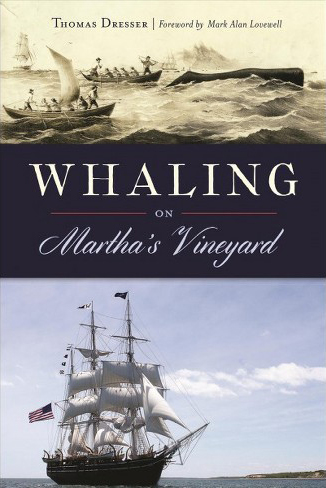Whaling on Martha’s Vineyard by Thomas Dresser, The History Press, 2018, softcover, 173 (with intro and index), $21.99.
It’s a testament to Tom Dresser’s storytelling gifts that a subject as big as whaling on the Vineyard can be told so well in only 150 pages. Whaling on Martha’s Vineyard is Mr. Dressers 10th Vineyard-related book for The History Press. He shifts his narrative confidently in these pages from broad-sweep history to colorful anecdotes and back. The tale begins with the Vineyard’s native Wampanoag Indians, who regularly harvested beached carcasses and hunted whales offshore with spears and harpoons in primitive dugouts hundreds of years before the first European settlers tried it themselves, in 1620, 21 years before Thomas Mayhew founded the first permanent white settlement on Martha’s Vineyard.
In little more than a century, this ad hoc approach had become a system and moved into deep sea waters. The Vineyard’s whaling industry was never extensive enough to rival that of Nantucket but as Mr. Dresser writes, “the Vineyard had a well-earned reputation for producing many whaling captains in the nineteenth century.”
Vineyard whaling captains and men shipped out everywhere, finding colorful adventures in all the whaling grounds of the Atlantic Ocean, and then the Pacific and even the Arctic, in search of increasingly rare rich whaling grounds.
“When whale oil became scarce,” Mr. Dresser writes, “the whaling industry had nowhere else to go.”
Whaling on Martha’s Vineyard goes with them, and Mr. Dresser relates many of the choicest of those adventures. Whalers left their families and loved ones for months or even years at a time, and conditions on board were squalid and dangerous. The book has an entire chapter on famous whaleship mutinies, like the one that took place in 1822 aboard the Globe, in which young 29-year-old Captain Thomas Werth and three of his officers were killed by a Nantucket man named Samuel Comstock, who fancied setting himself up as the king of some South Seas island but was instead killed by his own mutinous cohorts in short order.
The book also recounts the exploits of the few Vineyard women who followed their men to sea. Caroline Mayhew, for example, wife of the captain of the Powhatan, navigated the ship and tended to a crew stricken with smallpox during an 1846 voyage when a quarantine prevented Cape Verde doctors from coming on board. Dresser writes simply, “Caroline believed in cleanliness and fresh air, separated the sick from the well, and healed everyone.”
Like all History Press books, Whaling on Martha’s Vineyard is generously illustrated — mostly with shots from the New Bedford Whaling Museum — and in his acknowledgements Mr. Dresser thanks the archives of the Martha’s Vineyard Museum and the files of the Vineyard Gazette (whose editor, Henry Beetle Hough, was himself the son of a whaling captain).
Through an array of primary sources, Mr. Dresser follows his subject to its sputtering end at the dawn of the 20th century. Norway, Japan and Iceland (and numerous non-state actors) might still hunt whales in violation of international agreement, but the wild, adventurous days Mr. Dresser chronicles are gone forever.
“Today there are those who lament the passing of this undoubtedly picturesque, though certainly ruinous industry,” wrote Henry Kittredge bitterly in his 1930 classic Cape Cod, Its People and Their History. “But the world is a better place without long-voyage whaling than it ever was with it.”
That industry is now preserved entirely, as Mr. Dresser writes, “in our history books and museums.”
His own book is less than one-tenth the length of the great epic of whaling, Moby-Dick, but a good deal of both the picturesque and the ruinous is here as well.








Comments
Comment policy »